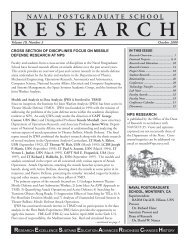Spectral Unmixing Applied to Desert Soils for the - Naval ...
Spectral Unmixing Applied to Desert Soils for the - Naval ...
Spectral Unmixing Applied to Desert Soils for the - Naval ...
You also want an ePaper? Increase the reach of your titles
YUMPU automatically turns print PDFs into web optimized ePapers that Google loves.
I. INTRODUCTION<br />
A study published by Doug V. Prose in 1985 looked at <strong>the</strong> persisting effects of<br />
military maneuvers on soils in <strong>the</strong> Mojave <strong>Desert</strong> (Prose, 1985). This study revealed that<br />
tracks left in a single pass of military equipment caused soil resistance (or electrical<br />
conductivity) 50% greater than in areas that were undisturbed. The study also indicated<br />
that despite diminished visible evidence, <strong>the</strong>re were underlying effects in <strong>the</strong> soil such as<br />
vertical and lateral increases in bulk density and soil impenetrability. The implications<br />
are that even minimal surface disturbances have measurable impacts on desert soils that<br />
can serve as indica<strong>to</strong>rs of activity.<br />
Based on <strong>the</strong> idea posed by Prose (1985), this <strong>the</strong>sis has sought <strong>to</strong> demonstrate<br />
that one can use endmembers from a geographically different yet geologically similar<br />
area in conjunction with satellite imagery, and spectral mixture analysis <strong>to</strong> detect sub-<br />
pixel surface disturbances related <strong>to</strong> anthropogenic uses in arid environments. <strong>Spectral</strong><br />
unmixing allows analysis of <strong>the</strong> distribution of surface components within a single image<br />
picture element (pixel) not visible <strong>to</strong> <strong>the</strong> naked eye and can be exploited <strong>to</strong> detect<br />
signature changes related <strong>to</strong> anthropogenic surface disturbances (Goetz et al., 1985).<br />
Areas with high concentrations of altered soil components can be mapped and analyzed<br />
<strong>to</strong> gain understanding of <strong>the</strong> spatial extent and location of those changes; providing<br />
comprehensive knowledge of target areas. To be able <strong>to</strong> use <strong>the</strong>se soil components <strong>for</strong><br />
such applications gives us an edge on adversaries allowing us <strong>to</strong> track activity locations<br />
in a timely manner. By creating a library of spectral properties of soil types exposed <strong>to</strong><br />
various surface disturbances in geologically similar conditions, surface disturbances in<br />
remote areas should be spectrally detectable on a sub pixel level in imaging spectrometer<br />
data; thus providing a means of analyzing large areas <strong>for</strong> signs of activity.<br />
As a spaced based asset, this technology poses <strong>the</strong> opportunity <strong>to</strong> conduct<br />
adversary tracking in regions that are highly inaccessible. The ability <strong>to</strong> use endmembers<br />
from easily accessed areas <strong>to</strong> detect spectral changes in desert soils in general, enables<br />
quick response and potential mitigation ef<strong>for</strong>ts <strong>to</strong> be more effective in <strong>the</strong> long haul. As<br />
adversaries continue <strong>to</strong> adapt <strong>to</strong> current remote sensing methods, it becomes more<br />
1
















